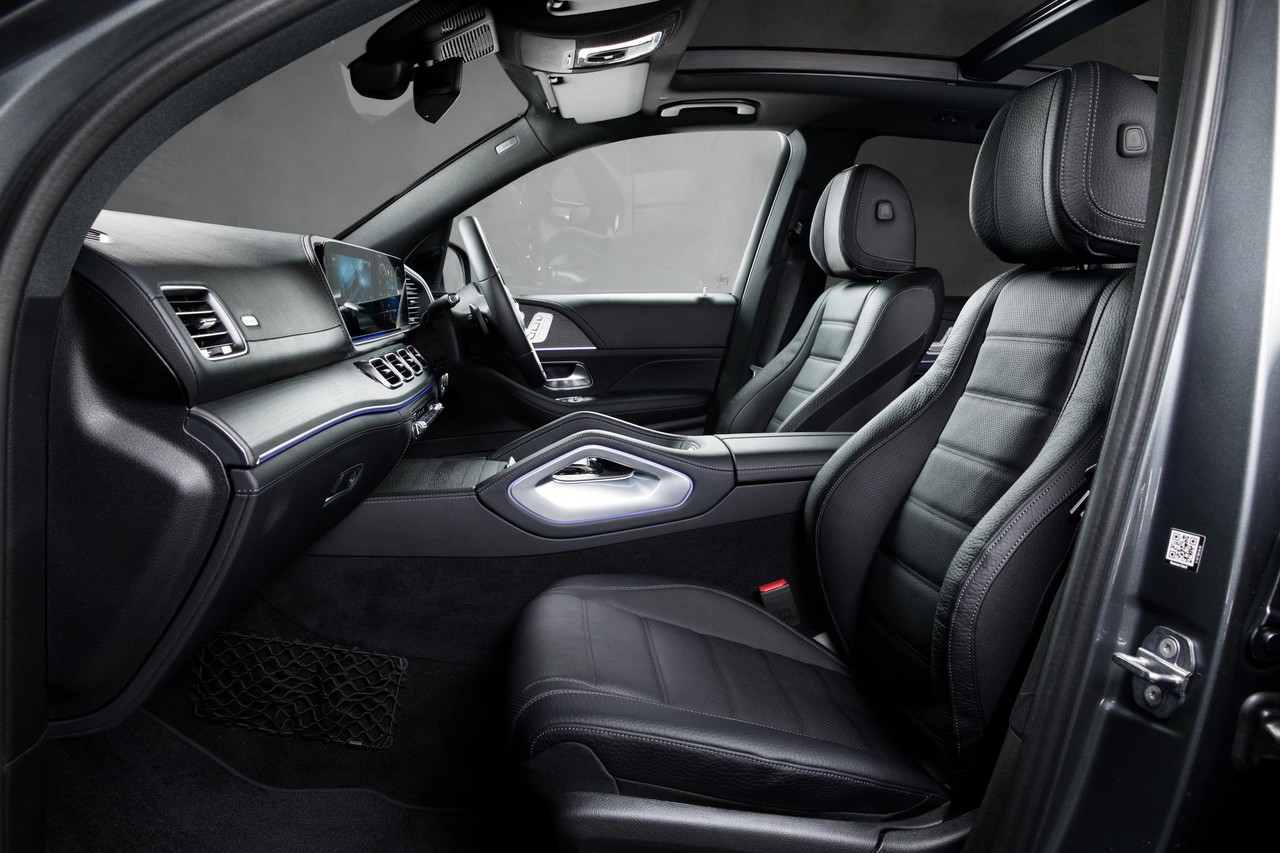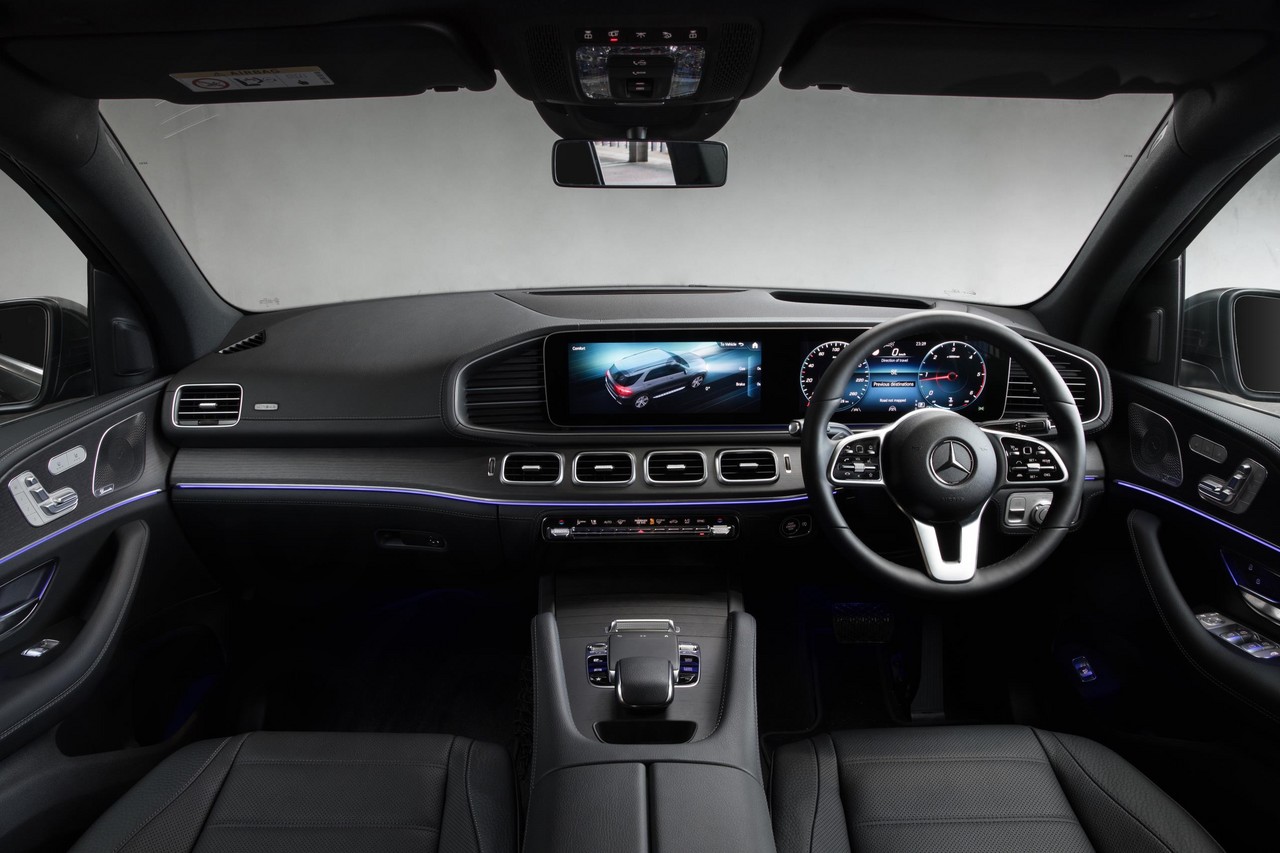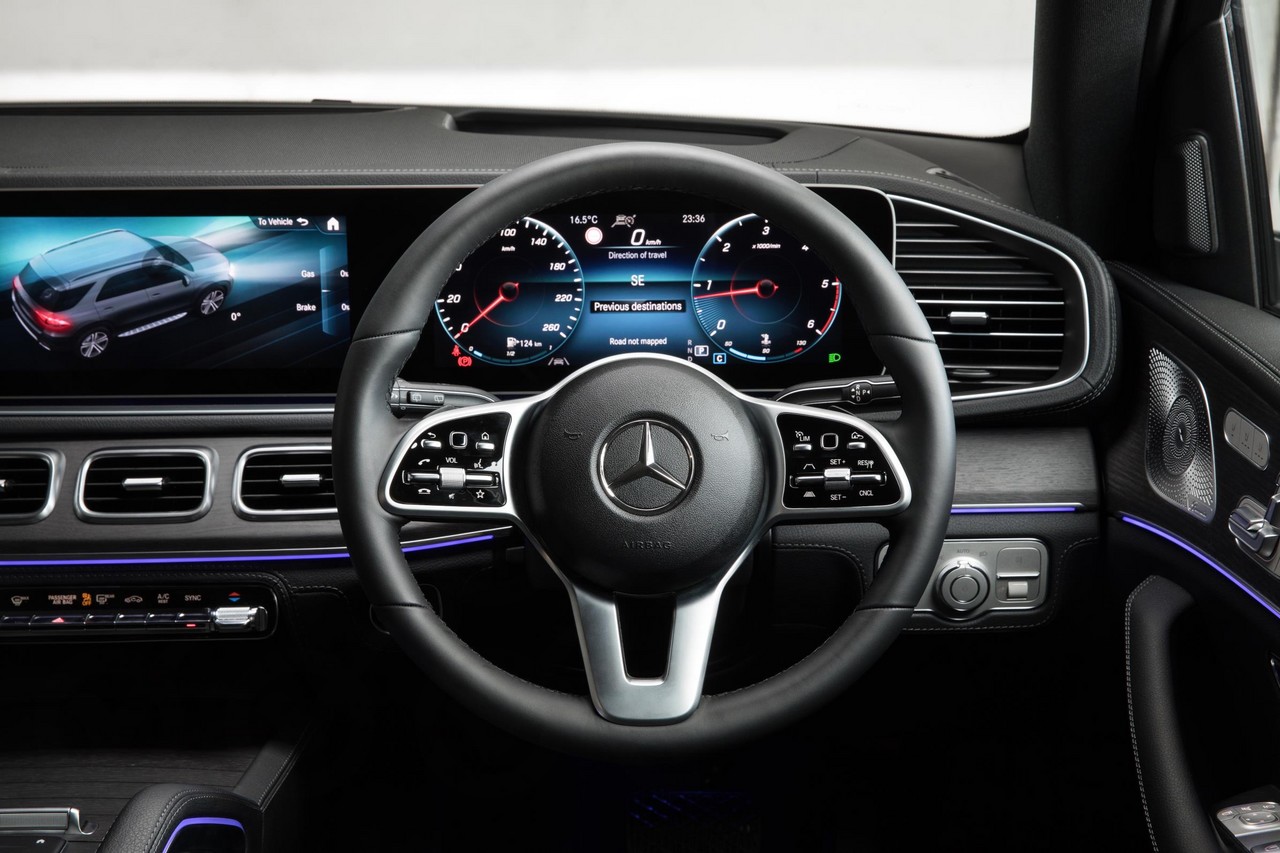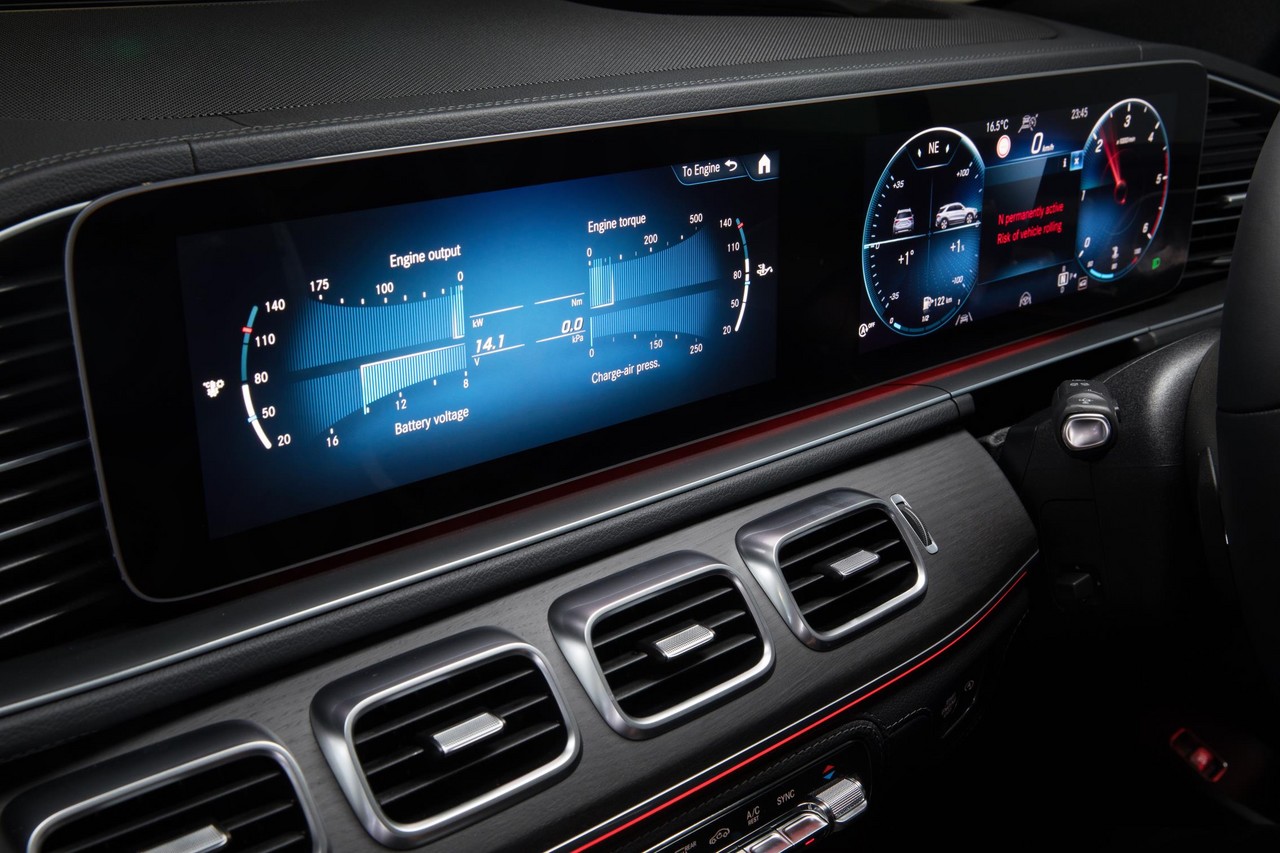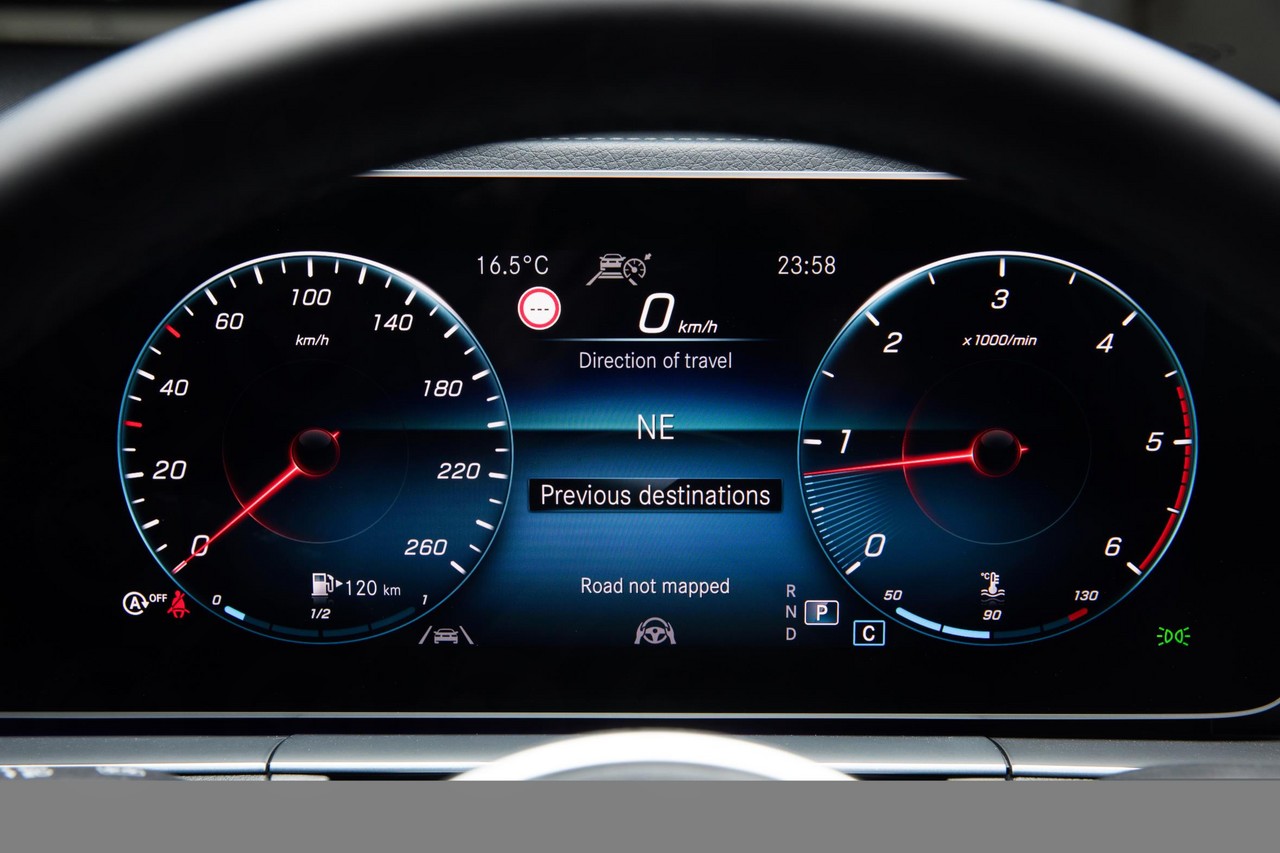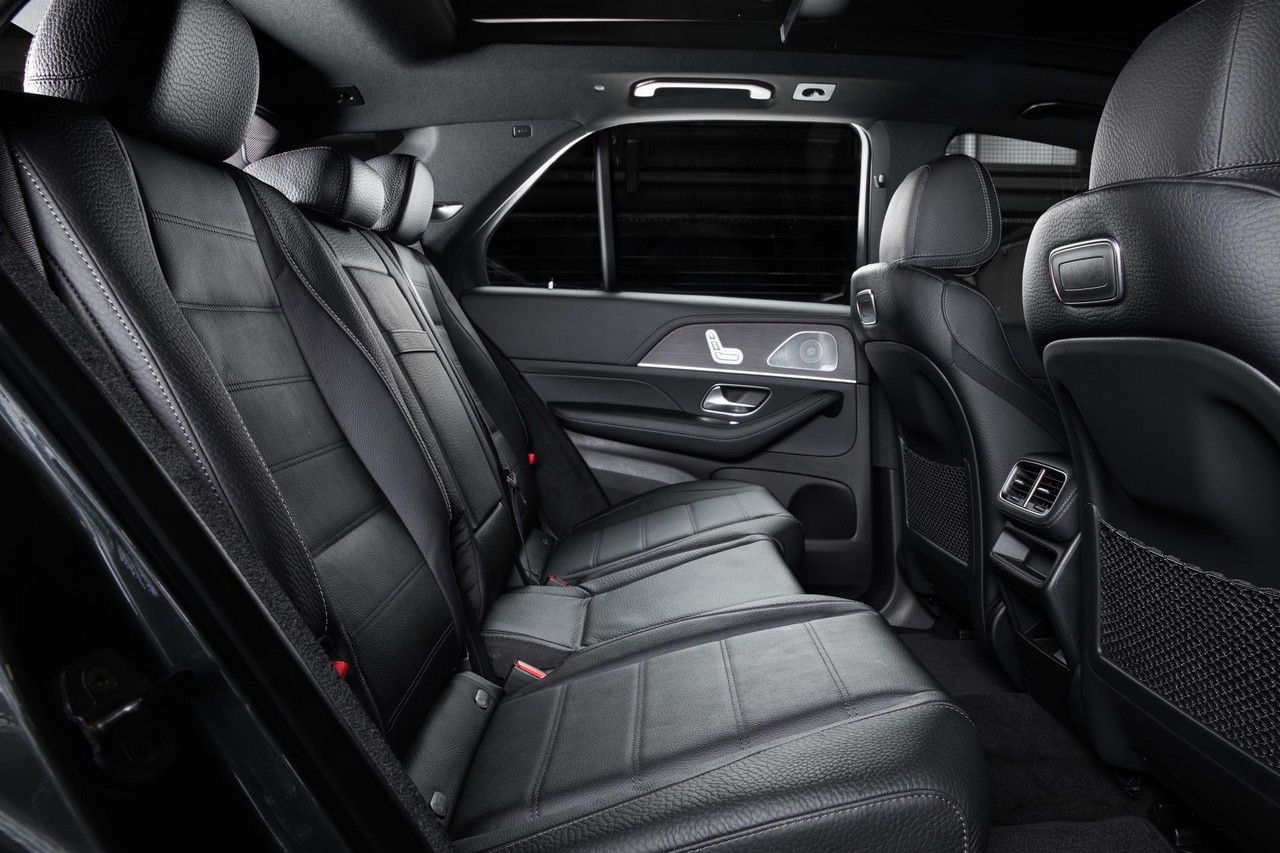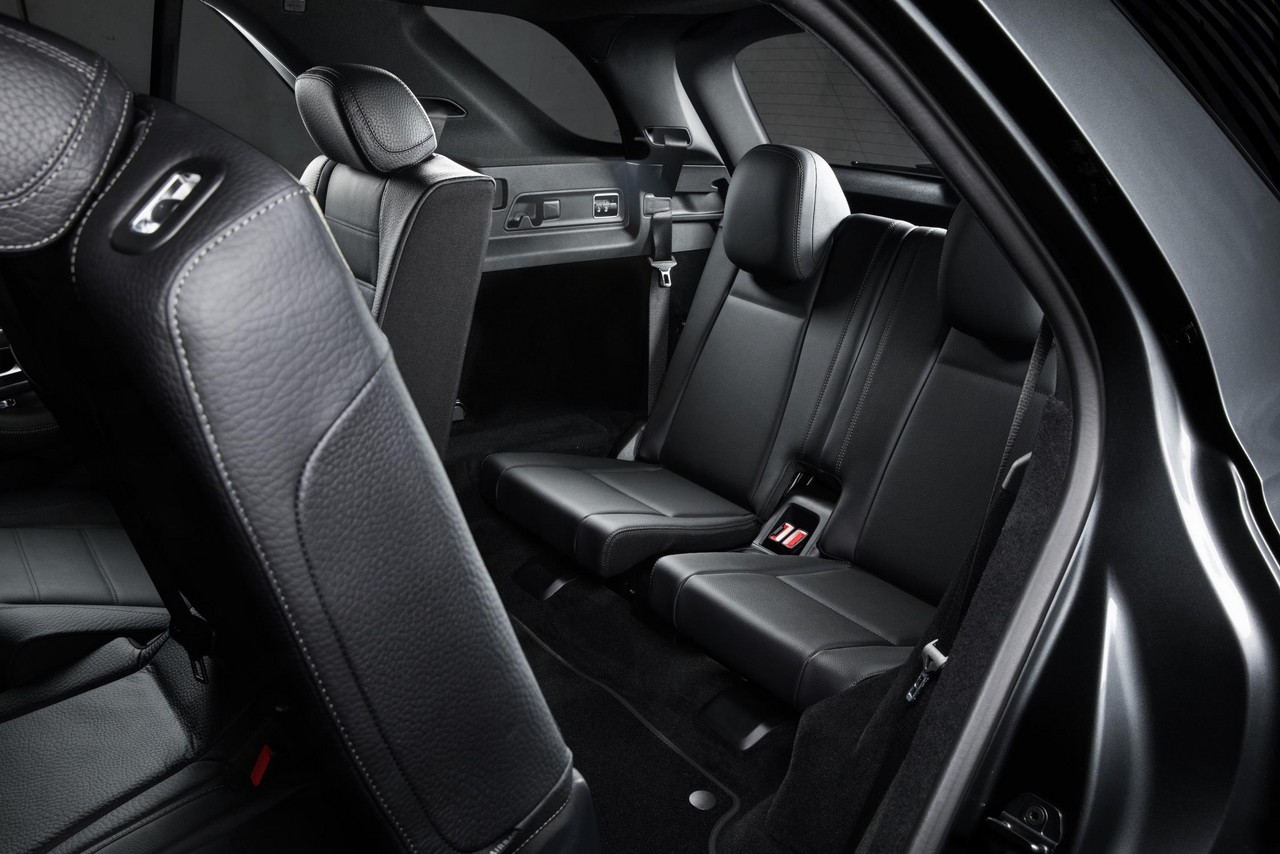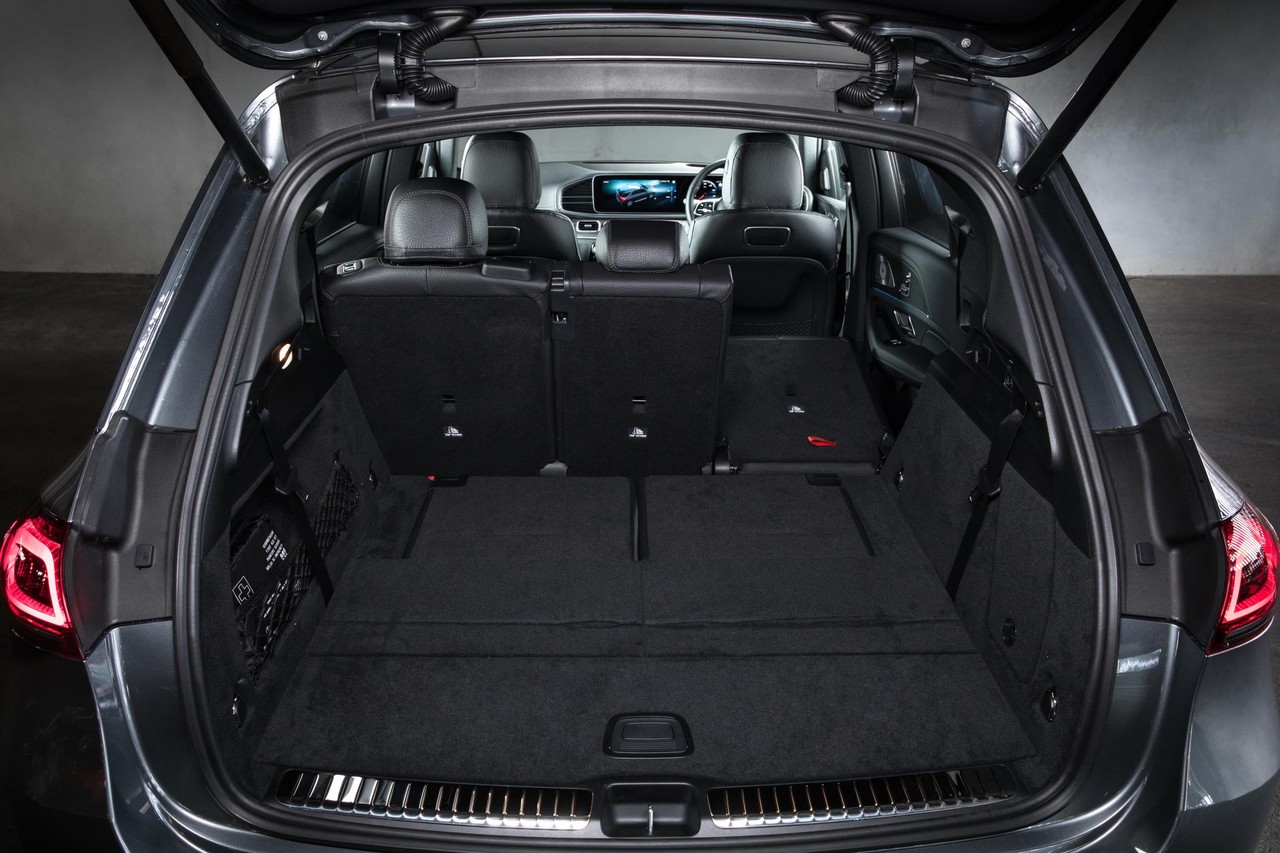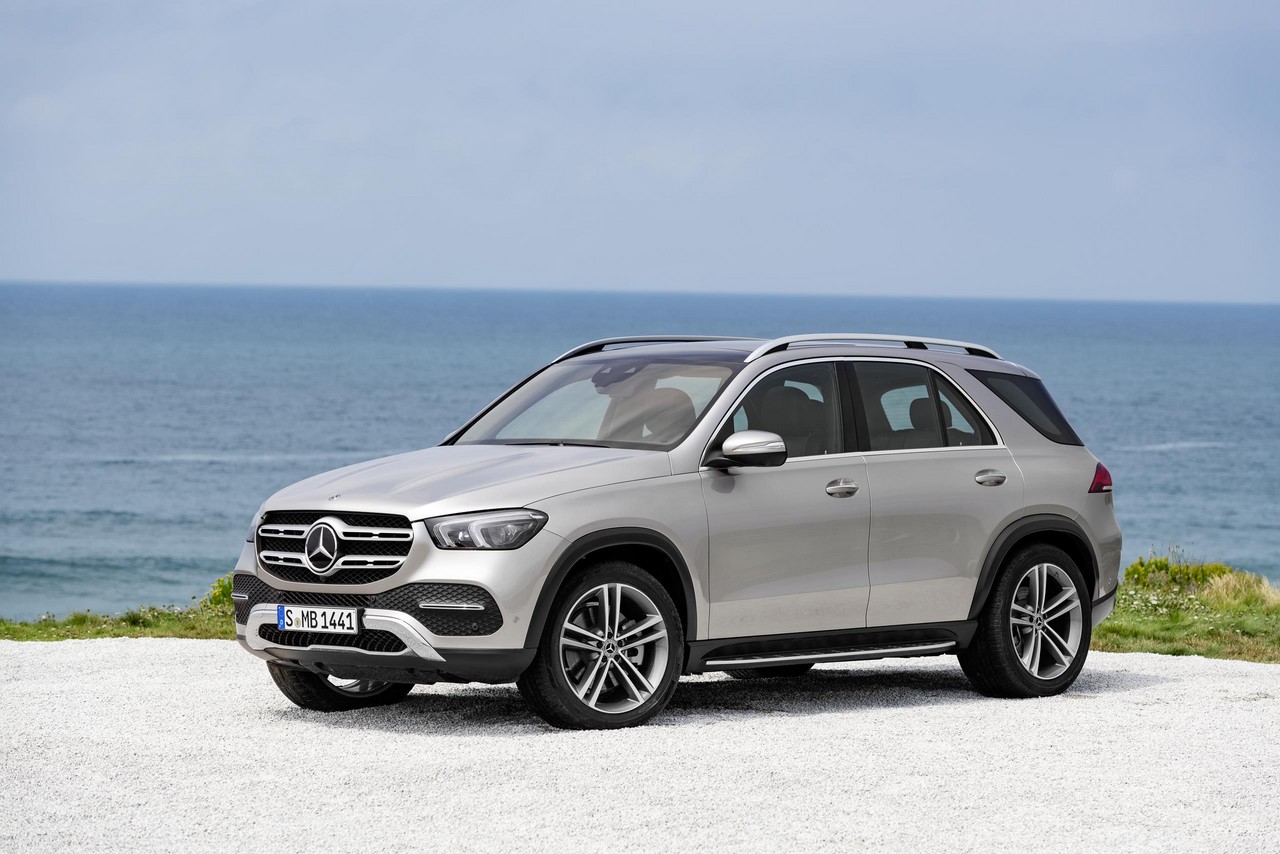
- Air suspension provides comfortable ride, but isn’t standard
- Refined nine-speed automatic transmissions
- Well-weighted steering
- Improved body control
- Firmer, more supportive seats
- Five star Euro NCAP safety rating
- Engines are fuel-efficient…
- … but the V167 GLE is a very heavy car
- Interior materials still fall short of class leaders (hard plastics and synthetic leather)
- Wireless device charging not standard
Overview
Released in Australia in July 2019, the Mercedes-Benz V167 GLE-Class was a large SUV that had five seats as standard, but could be fitted with two third-row seats as an option. Manufactured in Vance, Alabama, the Mercedes-Benz V167 GLE-Class was available in GLE 300d, GLE 400d and GLE 450 models (see table below).
To reduce fuel consumption, all engines had an ‘ECO start/stop’ function which enabled them to shut down when the vehicle was stationary in traffic.
V167 GLE 450: EQ Boost
The Mercedes-Benz V167 GLE 450 featured Mercedes’ ‘EQ Boost’ system which used a 48 volt onboard network and a belt-driven starter/alternator to provide the following functions:
- When accelerating, EQ Boost could assist the engine with an additional 16 kW until the turbocharger accumulated full charge pressure;
- The EQ Boost function would also assist the engine to reach its ideal operating speed as quickly as possible during gearshifts to reduce shift times;
- During deceleration, the starter/alternator would recuperate kinetic energy and charges the battery;
- The water pump was electrically driven and actuated by a characteristic map to adapt cooling output according to need; and,
- Below a certain speed, a ‘glide mode’ would decouple the engine from the drivetrain to avoid engine braking and the engine would switch off to reduce fuel consumption.
| Engine | Trans. | Peak power | Peak torque | |
|---|---|---|---|---|
| GLE 300d 4MATIC | 1950 cc OM654 biturbo diesel I4 | 9sp auto | 180 kW at 4200 rpm | 500 Nm at 1600-2400 rpm |
| GLE 400d 4MATIC | 2925 cc OM656 biturbo disesel I6 | 9sp auto | 243 kW at 3600 rpm | 700 Nm at 1200-3000 epm |
| GLE 450 4MATIC | 2999 cc M256 biturbo petrol I6 | 9sp auto | 270 kW at 5500 rpm + 16 kW EQ Boost | 500 Nm at 1600-4500 rpm + 250 Nm EQ Boost |
4MATIC all-wheel drive system
The Mercedes-Benz V167 GLE 300d and 400d models had a full-time four-wheel drive system (‘4MATIC’) with open differentials. In normal conditions, the transfer case in the ‘4MATIC’ system provided a 50:50 front:rear torque split. In the event that any wheel lost traction, the four-wheel traction control system (‘4ETS’) would brake that spinning wheel so that torque would be transferred to the wheels with grip.
The Mercedes-Benz V167 GLE 450, however, had an electronically-controlled multi-disc clutch. According to Mercedes-Benz, this Torque on Demand (TonD) system allowed a variable transfer of drive torque from 0-100 per cent between the axles.
As an option, the Mercedes-Benz V167 GLE 450 could be specified with a transfer case that was configured for off-road driving. In addition to the multi-disc clutch, this transfer case had a reduction gear set and an automatic locking effect from 0-100 per cent for off-road driving.
Body and dimensions
The V167 GLE-Class was underpinned by Mercedes-Benz’s ‘Modular High Architecture’ (MHA) which achieved a 33 per cent increase in rigidity over the W166 M-Class . Compared to the Mercedes-Benz W166 GLE-Class which it replaced, the Mercedes-Benz V167 GLE-Class was 111 mm longer (at 4930 mm), 15 mm wider (1950 mm), 31 mm lower (1765 mm) and had an 80 mm longer wheelbase (2995 mm); ground clearance was 212 mm for the GLE 300d and GLE 400d, but 180 mm for the GLE 450. Inside, the 40:20:40 split and folding second row seats could slide forward or backwards; in their rearmost position, luggage capacity was 630 litres. Furthermore, unladen weights for the Mercedes-Benz V167 GLE-Class ranged from 2403 kg (GLE 300d) to 2507 kg (GLE 450).
Aerodynamic measures for the Mercedes-Benz V167 GLE-Class included:
- A radiator grille shutter for needs-based metering of airflow (‘Airpanel’);
- Wheel spoilers with mouldings ahead of the front wheels;
- Optimised door mirrors;
- Wheel spoilers in front of the rear wheels;
- Side spoilers with D-pillar seals on the tailgate;
- Spoiler lips for the tail-lights;
- Underbody and propshaft tunnel panelling, flush fuel tank cladding, cladding on the rear axle and an optimised diffuser lining; and,
- Aerodynamically designed wheels.
In combination with the AIRMATIC package (see ‘Suspension’, below), the Mercedes-Benz V167 GLE-Class had a full underbody guard for improved aerodynamics. With this, the Mercedes-Benz V167 GLE-Class had a drag co-efficient of 0.29 Cd.
Suspension
The Mercedes-Benz V167 GLE-Class had double wishbone front suspension and multi-link rear suspension. The standard suspension for the GLE-Class consisted of steel springs and electronically controlled dampers. Available as an extra-cost option, however, Mercedes-Benz’s ‘AIRMATIC’ package consisted of:
- Three-chamber height adjustable air suspension; and,
- Electronically control dampers.
Available as an extra-cost option for the V167 GLE 450, Mercedes-Benz’s ‘E-Active Body Control’ combined:
- ‘Road Surface Scan’ which used on-board cameras to identify imperfections in the road surface and adjust suspension damping at each individual wheel; and,
- A curve-tilting function (‘Curve’) so that the vehicle could lean into bends by shifting the base point of each individual suspension strut.
Steering
The Mercedes-Benz V167 GLE-Class had rack-and-pinion steering with electric power assistance.
Safety equipment
Standard safety equipment for the Mercedes-Benz V167 GLE-Class included dual front airbags, seat-mounted airbags for front and second row occupants, full-length curtain airbags, a driver’s knee airbag, ABS, electronic brakeforce distribution, brake assist, electronic stability control, traction control and front seatbelts with pre-tensioners and load limiters.
Beyond this, the Mercedes-Benz V167 GLE-Class was equipped with the following active safety technologies –
- Active Distance Assist Distronic with Active Steering Assist: operating at speeds up to 210 km/h, the system could maintain a pre-set distance to the vehicle ahead. A stop-and-go function also enabled the vehicle to be braked until stationary, remain stationary for up to 30 seconds and then accelerate when the traffic ahead started moving. Active Distance Assist Distronic also combined navigation data with camera/radar inputs to adjust speed when approaching bends, junctions or roundabouts;
- Active Brake Assist with cross-traffic function: could mitigate the consequences of collisions with vehicles or pedestrians in front of the vehicle. If a collision risk was detected, the system initially issued a visual warning. If there was a serious risk of collision, the driver received an additional, audible warning and the required brake pressure to prevent a collision was calculated (if possible) so that it could be applied when the driver depressed the brake pedal. If the driver failed to respond, however, Active Brake Assist initiated autonomous emergency braking to mitigate or prevent the collision. For the V167 GLE-Class, a new ‘turning-off function’ was introduced such that if there was a danger of a collision with oncoming traffic when exiting (‘turning-off’) a carriageway, the vehicle could be braked at speeds typical of such manoeuvres;
- Active Steering Assist: helped the driver keep the vehicle in the centre of its lane by applying steering wheel torque. Active Steering Assist used the lane markings for orientation at speeds up to 210 km/h and, at speeds up to 130 km/h, also used the position of vehicles ahead. For the V167 GLE-Class, Active Steering Assist introduced a new feature to assist the driver in forming a rescue lane on multilane roads. Specifically, the vehicle would be guided to the edge of the lane it currently occupies. When a queue of stationary or slow-moving traffic was detected on motorways at speeds below 60 km/h, off-centre guidance of the vehicle was assisted;
- Evasive Steering Assist: supported the driver in taking evasive action when pedestrians were detected in front of the vehicle and the driver initiated such action. The system would apply additional steering torque in the direction the driver was performing an evasive manoeuvre to help the driver evade the pedestrian in a controlled manner and then to ‘stabilise’ the vehicle;
- Active Lane Change Assist: operating at speeds from 80 km/h to 180 km/h, Active Lane Change Assist could perform lane changes – within 10 seconds – in response to the driver nudging the indicator stalk;
- Active Lane Keeping Assist: could detect when the adjacent lane was occupied (including oncoming traffic) and prevent the driver from inadvertently exiting from the lane when it was not safe to do so by applying a corrective braking force to the wheels on one side of the vehicle;
- Active Blind Spot Assist: active at speeds above 60 km/h, a corrective braking force would be applied to the wheels on one side of the vehicle if the driver attempted to change lanes when a vehicle was detected in the driver’s blind spot;
- Exit Warning Assist: could issue a visual warning in the door mirror when the vehicle was stationary and up to three minutes after the ignition had been turned off to warn of an approaching vehicle or bicycle (providing it was exceeding 2 m/s). If the driver used the door handle at this moment, an additional acoustic warning would be issued;
- Active Emergency Stop Assist: if it was detected that the driver was no longer actively driving the vehicle while it was moving, Active Emergency Stop Assist would bring the vehicle to rest within its lane. If there was no steering wheel movement over a longer period when Active Steering Assist (see below) was active, the system issued visual and audible prompts for the driver to place their hands on the steering wheel. If the driver failed to respond, vehicle speed was reduced until it was stationary. At speeds below 60 km/h, following traffic was warned by the hazard warning lamps;
- Attention Assist with drowsiness detection: operated at speeds in excess of 80 km/h and assessed driver behaviour (including steering movements) for signs of drowsiness. If detected, the driver would be provided with visual and audible warnings;
- Traffic Sign Assist: used navigation data and image recognition to display – in the instrument cluster – the maximum permitted speed, restrictions on overtaking and pedestrian warnings near ‘zebra’ crossings. Traffic Sign Assist also had an extended wrong-way warning, while the detection of stop signs was been combined with the ECO start/stop function so that the engine would remain on. Active Speed Limit Assist was a sub-function of Traffic Sign Assist that used the forward-facing camera to recognise sign gantries and road works signs to set the vehicle’s maximum speed; and,
- Pre-Safe Plus: used the rear radar sensors to detect if a rear-end collision was imminent and, if so, flashed the rear hazard lights and prepared occupant protection measures such as the seatbelt tensioners. If the vehicle was stationary and the risk of a collision persisted, the system could apply the vehicle’s brakes to reduce the risk of injuries by reducing the forward jolt caused by an impact from the rear.
Euro NCAP testing
In Euro NCAP testing , the Mercedes-Benz V167 GLE-Glass received a five star safety rating which included a 91 per cent adult occupant protection rating and a 90 per cent child occupant protection rating. In the frontal offset test, protection of the driver’s head, thighs and feet were rated as good, though protection of the chest and lower legs was rated as adequate (i.e. a slight risk of serious injury). Maximum points were awarded in the side impact test; in the more severe pole test, however, chest protection was rated as marginal (i.e. a moderate risk of serious injury).
Features: Mercedes-Benz V167 GLE 300d, 400d and 450
The infotainment system for the Mercedes-Benz V167 GLE-Class featured the ‘MBUX’ driver interface which consisted of a 12.3-inch touchscreen and a 12.3-inch display for the instrument cluster, a sound system with digital radio tuner (DAB+), satellite navigation, Bluetooth mobile phone connectivity, voice control (‘Linguatronic’ and smartphone integration (Apple CarPlay and Android Auto).
Standard features for the Mercedes-Benz V167 GLE-Class included 20-inch five-spoke alloy wheels, ‘Thermatic’ climate control air conditioning, dusk-sensing headlights, rain-sensing wipers, heated front seats, a head-up display (resolution of 720 x 240 pixels), 40:20:40 split and folding second row seats, leather-wrapped steering wheel with gearshift paddles, remote central locking, power adjustable and heated door mirrors with folding function, power windows, a height and reach adjustable steering wheel, an electric park brake, illuminated vanity mirrors, velour floor mats, a 12 volt power socket (load area), aluminium roof rails, a power-operated tailgate which could be operated by foot motions beneath the rear bumper (‘Easy-Pack Tailgate’), a trip computer, an alarm and immobiliser.
As standard, the Mercedes-Benz V167 GLE-Class was equipped with Multibeam LED headlamps which featured:
- High-performance LED chips in each headlight module;
- Four control units which calculated the ideal lighting using information from the forward-facing camera to avoid dazzling other drivers (‘Adaptive Highbeam Assist Plus’) and from the navigation system – this included swivelling the light beams into bends (‘Active Lighting System’); and,
- An ‘Ultra Range’ high beam that had brightness above 1 lux over a distance of more than 650 metres. At speeds above 40 km/h and when there was no other traffic, the ‘Ultra Range’ high beams were automatically switched on.
Specifications


